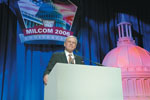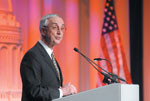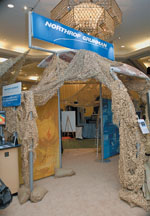Warfighters Need Faster, Improved Access to Information
 |
| Tom Brokaw, former anchor and managing editor of NBC Nightly News, called for renewed patriotism at MILCOM 2006. |
The U.S. Defense Department is shifting away from building its own communications tools and services and is reaching out to the private sector for help in providing information to those who need it. The public sector is seeking to form partnerships with industry based on open standards, network centricity and collaboration between developers and end users to supply tools to the troops before the technology is obsolete.
Leaders from all four branches of the military, the Defense Department and private industry as well as representatives from foreign nations converged on
“It’s all about the information. Information is our greatest weapon—is
Information is being shared in a new way through the vision of network centricity, which moves data horizontally and vertically instead of from point to point. To achieve network centricity, the communications field has to undergo a transformation in mindset and culture, related Vice Adm. Nancy E. Brown, USN, director, command, control, communications and computer systems/J-6, the Joint Staff. During her keynote address, she called on industry to help meet the military’s goals.
“Our collective efforts are essential to this nation’s ability to enable net-centric forces today and tomorrow,” Adm. Brown said. She emphasized that military and industry need to work to increase interoperability, lower developmental costs, improve force readiness, diminish development risk, enhance warfighter effectiveness and reduce system cost sustainability.
 |
| Rebecca Cowen-Hirsch, director, SATCOM, Teleport and Services Program Executive Office, Defense Information Systems Agency (DISA), speaks to the audience during the DISA Industry Day held at MILCOM. Senior leaders from DISA formed a large panel to present information about their specialties and to answer questions from industry representatives. |
The modeling and simulation panel looked at the difficulties in creating realistic models. Dr. Marty Stytz, chief principal research scientist and engineer, U.S. Air Force Research Laboratory, gave a presentation on human behavior modeling and retrospective and future challenges for command, control and communications. “Getting inside enemies’ minds and having elite, trained forces are crucial [to winning battles],” Stytz shared. “Unfortunately, it’s really hard to do.” Human behavior modeling is challenging because of the uncertainties in human decision making, he said. For instance, in current conflicts, understanding why suicide bombers choose to kill themselves and re-creating the situation in a simulation are demanding tasks. “It’s very hard—and I can’t emphasize this enough, it’s very hard to model what makes a person become a suicide bomber,” Stytz said.
He also called for models that address asymmetric warfare and concluded that human behavior modeling is behind the curve but has a solid foundation. Researchers and developers know the actions they need to take, but cost and time are major obstacles. Panelists also informed the audience that the Defense Department is working to improve standards on modeling and simulation tools.
Tom Brokaw, former anchor and managing editor of NBC Nightly News, discussed patriotism and improving the political situation in the
DISA hosted its industry day during MILCOM, at which 18 key agency officials, including Gen. Croom, answered questions from the audience. The general challenged audience members to ask his staff difficult questions and emphasized that DISA wants to partner with industry to find solutions for military communications needs. Throughout the dialogue between the audience and staff members, DISA officials reiterated their commitment to finding available technologies instead of creating new ones and to improving acquisition and requirements. Leaders want to speed the acquisition cycle, which would allow them to stay current with emerging technologies, and to simplify requirements for programs. Gen. Croom told the audience he would like to buy more managed services. “We’d like to pay you by use,” he said. “And if you want to play, you’ve got to sign up.” DISA recently awarded its first capacity-on-demand contract for server processing.
Gen. Croom and DISA officials are seeking to change the way the Defense Department delivers information technology. End users and developers should work together on projects so systems have the necessary capabilities. Products should be developed, tested and certified in the same environment to deliver capabilities to the warfighter faster. Across the department, programs can be tested and certified against common standards to move away from service stovepipes.
Interoperability between technologies still hampers parties working together as do laws and regulations about information sharing. During the “DOD and First Responder Communications” panel, speakers enlightened the audience about the role of communications policy and technology between the National Guard, first responders, the military, the U.S. Department of Homeland Security (DHS) and private industry.
Priority needs to be placed on not only enabling responders to communicate during an emergency but also repairing damaged communications lines to the public after a disaster. Col. Victoria Velez, USAF, chief of staff, National Communications System, DHS, stated that restoring commercial communications following a disaster is essential to recovery and that assisting the process is in the interest of all levels of government. She spoke on the need to credential DHS and industry personnel to allow them access into distressed areas to repair communications.
Later in the day, John G. Grimes, assistant secretary of defense for networks and information integration and Defense Department chief information officer, returned to the information theme during his speech. “We must change now how we think of information and how it’s used,” he said. Grimes urged listeners to move to a culture that embraces and leverages information instead of viewing information as power and refusing to share it. Grimes echoed Gen. Croom’s comments, adding that the Defense Department will not develop services that already exist and that it needs to shift away from service stovepipes. He emphasized the importance of network centricity in delivering information to warfighters and said that industry and government must partner to make communications initiatives successful.
 |
| Gordon England is the deputy secretary of defense. |
 |
| Mission Possible, a new feature for MILCOM 2006, gave companies an opportunity to demonstrate their technologies in response to a fictional crisis scenario. The showroom was decorated to transport visitors to the field environment as exhibitors showcased how their capabilities would apply to the situation. |
MILCOM featured a classified program with its own speakers, sessions and panels, including a keynote address by Rear Adm. Victor C. See Jr., USN, director, Communications Systems Acquisition and Operations Directorate, National Reconnaissance Office.
This was the 25th anniversary of MILCOM and the largest event to date, with more than 5,300 attendees at the conference and exhibition. MILCOM is co-sponsored by AFCEA International and the
Photographs by Robert A. McComas Photography.
The nation of Iroma has been enduring political and economic harassment from its neighbor, the rogue state Mallipina. Recently, Mallipina began conducting “war games” close to its shared border with Iroma and has amassed numerous troops and weapons there. Today the leader of Mallipina declared the border invalid. Missile transports have been spotted, and reports are coming out of the region that indicate border crossings and communications outages. A conference of nonallied leaders has met to address the situation. This is not the beginning of a new world conflict but an exhibit hall scenario called Mission Possible, a new feature for MILCOM 2006 designed around a predetermined, fictional conflict. The project provided a venue for companies and government organizations to demonstrate cutting-edge command and control technologies. Mission Possible afforded participants the opportunity to display exactly how their technologies would apply to a real-world situation. All the capabilities had to be available in the market, and in many cases the technology already is in use by the military. The hall entrance and many of the exhibit booths that were a part of Mission Possible were designed to simulate the feel of field operations with props such as netting, sandbags and military vehicles and satellites. Attendees watched news updates from a fictitious national news network on televisions around the hall that portrayed the developing conflict between Iroma and Mallipina. Exhibitors showcased their methods for communicating around power outages and for providing interoperable communications. Cisco Systems Incorporated personnel demonstrated their ability to enable interoperability among the various forces in the scenario using a true satellite communications network. The network combines disparate parties by collecting information into its hub and communicating across different frequency bands. Staff set up equipment in the back of a sport utility vehicle and communicated among radios with different frequencies. Cisco also exhibited products designed to preserve and make good use of bandwidth by pre-empting calls based on precedence. Cisco personnel linked the Mission Possible booth to the company’s booth in an exhibit hall in another building, showing how the network reached across distance to support voice, data and video requirements. Northrop Grumman Corporation demonstrated a range of capabilities at its exhibit, including a portal developed for Multi-National Force–Iraq. The company also walked visitors through the role the Defense Integrated Military Human Resources System (DIMHRS) could play in the scenario. In addition to its uses to resolve payment issues, DIMHRS can be used to track service members, updating location and personnel condition in a central database. For example, were a warfighter to be injured in the field, a commander could input the information into the DIMHRS database. The system can be accessed worldwide, reducing theamount of lost or late paperwork that hinders effective troop processing. Other exhibitors in the Mission Possible hall showcased a range of tools with the command and control capabilities necessary to address the requirements of the scenario. MILCOM 2006 officials hope to see similar demonstrations at future conferences. |




Comments